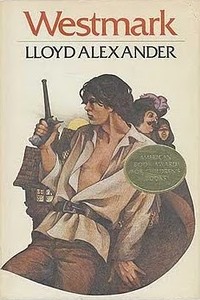 Readers’ Digest Condensed Books takes it on the chin from many quarters – dumbed down books stripped down for readers who place more value on popular titles than quality reads. Looking back at them now, it seems that Readers’ Digest was the only transition from kids’ books to “adult” literature I had access to. My brother and sisters and I would check the mail every day, and when that box turned up it was Katy, bar the door. And while we were waiting there was always the shelf full of previous collections we could grab. Now, most of the books weren’t memorable, but others set me on the path of my pleasure reading, and where’s the harm in that?
Readers’ Digest Condensed Books takes it on the chin from many quarters – dumbed down books stripped down for readers who place more value on popular titles than quality reads. Looking back at them now, it seems that Readers’ Digest was the only transition from kids’ books to “adult” literature I had access to. My brother and sisters and I would check the mail every day, and when that box turned up it was Katy, bar the door. And while we were waiting there was always the shelf full of previous collections we could grab. Now, most of the books weren’t memorable, but others set me on the path of my pleasure reading, and where’s the harm in that?
Once an Eagle was a transition from my childish understanding of war to a more sober take on its dark and dirty side. The story of one man’s Army career from private in the futile search for Pancho Villa to retired general seeing the early signs of the coming war in Vietnam, it is also the story of the American military through the 20th century.
Sam Damon grows up in a small Midwestern town, hearing tales of glorious and deadly battles from veterans of the Civil War and the Philippine American War. He joins as a private soldier at a time when the Army was considered a refuge for drunks, brutes, and incompetents, but those men become the cadre around which newly-minted civilian soldiers became an Army in 1917. Damon is a powerful leader, inspiring loyalty and pulling reluctant men into his fearless wake. He frightens them, though – in battle he is savage and coldly brilliant, with the mythical luck of the born warrior. His successes earns him medals and brevet promotion, but his first loyalty is with his men. He also comes up against Courtney Massengale, a bloodless, politically-connected West Pointer who sees war as a series of staff exercises, and whose time-in-grade will keep him a half-step ahead of Sam throughout their parallel careers.
After 1918, Sam and his new family begin the grinding tour of moving from one camp to another to study his craft. With the world determinedly turning its back on the horror of the recent war, the Army once again becomes a backwater. But such backwaters creates a sense of community and continuity in their denizens, forming deep friendships and uneasy truces between enemies. It isn’t just the men, either – their wives are their allies, spies, and bulwarks against the maneuvering that might destroy a man’s career. There are also the common soldiers, rootless, bored, underpaid, and kept in line by relentless, sometimes cruel discipline.
Then war comes again, and the officers who have languished in rank are suddenly given armies to train and command. Damon’s war is in the Pacific, where repeated amphibious assaults give way to jungle fighting against an enemy that does not surrender. As an infantry commander on the beach, Damon has to rely on a Navy with its own agenda, a fledgling Army Air Corps, and a superior officer – Massengale – who still doesn’t see the blood and death his orders cause. Damon must call on his innate skills as a warrior, as a leader, and as a commander who must place professional duty above personal sacrifice. In the wake of the war, with no political patronage, those qualities get him put on the shelf. Until he’s needed to investigate a local brushfire war threatening American interests.
Myrer’s control over both his characters and their situations makes it easy to keep up with, even care about, the myriad of people who must populate a book about armies and war. Even after so long, I’m pretty sure I could even tell you what characters appear in what parts of the story and what their relationship to Damon is. Myrer’s descriptions of battle are detailed and horrible enough to strip the shine off the techo-thrillers and are reminders that war is, after all, friend only to the undertaker. I’m pretty sure Sam Damon would agree with Edwin Starr.
Revisiting the book as an adult, I made an interesting discovery about the condensation process Readers’ Digest used on this particular story. A significant section that has Damon travelling to China to observe the Communist guerrilla war against the Japanese. A heroic Chinese commander teaches him about both ideology and tactics, striking a sympathetic chord in both character and reader. That section was completely missing from the digested version, possibly because, up until recently, Reader’s Digest was a leading anti-Communist voice in American society. On the other hand, that same conservative approach took a lot of sex out of other books they condensed, which probably made it more palatable for the parents of pre-teens and adolescents like me and my siblings. Middlebrow? Maybe. But re-reading The Outsiders and Go Ask Alice wouldn’t have led me to travel through the lives and stories of so many different people and kept me reading until it became an indispensable part of my life.
Check the WRL catalog for Once an Eagle
Sam Elliott also starred as Sam Damon in an NBC miniseries that follows the novel pretty closely.
Read Full Post »
 Anyone coming from Winnipeg is well aware that the most famous of all bears, Winnie-the-Pooh, was named after that Canadian city. Many people know that the real Christopher Robin visited the real Winnie Bear at London Zoo, but London is thousands of miles away from Winnipeg, so the connection back to Canada is not well-known, even to fans of the Bear of Little Brain. Winnie: The True Story of the Bear Who Inspired Winnie-the-Pooh sets out to change this grave lack!
Anyone coming from Winnipeg is well aware that the most famous of all bears, Winnie-the-Pooh, was named after that Canadian city. Many people know that the real Christopher Robin visited the real Winnie Bear at London Zoo, but London is thousands of miles away from Winnipeg, so the connection back to Canada is not well-known, even to fans of the Bear of Little Brain. Winnie: The True Story of the Bear Who Inspired Winnie-the-Pooh sets out to change this grave lack!



 While the majority of people are (hopefully) aware of all-black regiments that have fought for America like the Tuskegee Airmen or the Buffalo Soldiers, many do not realize that there were black soldiers who fought in WWI. Highlighting a piece of our nation’s history that has been minimized, ignored, and forgotten, Max Brooks brings the story of the 369th Infantry Regiment roaring back to life. Although the account is fictional, much of the storyline and action comes directly from historical accounts. The amount of research that went into this book is readily apparent and helps ground the story in the mud-laden reality that was life in the trenches.
While the majority of people are (hopefully) aware of all-black regiments that have fought for America like the Tuskegee Airmen or the Buffalo Soldiers, many do not realize that there were black soldiers who fought in WWI. Highlighting a piece of our nation’s history that has been minimized, ignored, and forgotten, Max Brooks brings the story of the 369th Infantry Regiment roaring back to life. Although the account is fictional, much of the storyline and action comes directly from historical accounts. The amount of research that went into this book is readily apparent and helps ground the story in the mud-laden reality that was life in the trenches.



 August 2014 marks the centennial of the worldwide convulsion we call World War I. Many of the images we collectively identify with the war came from one region of the line: Flanders. The mud and shell holes which drowned soldiers, the devastated landscapes, the ancient towns reduced to rubble, the fruitless struggle for advances that could sometimes be measured in meters all characterized the hell which started at the North Sea and ended around the French border with Belgium.
August 2014 marks the centennial of the worldwide convulsion we call World War I. Many of the images we collectively identify with the war came from one region of the line: Flanders. The mud and shell holes which drowned soldiers, the devastated landscapes, the ancient towns reduced to rubble, the fruitless struggle for advances that could sometimes be measured in meters all characterized the hell which started at the North Sea and ended around the French border with Belgium.







